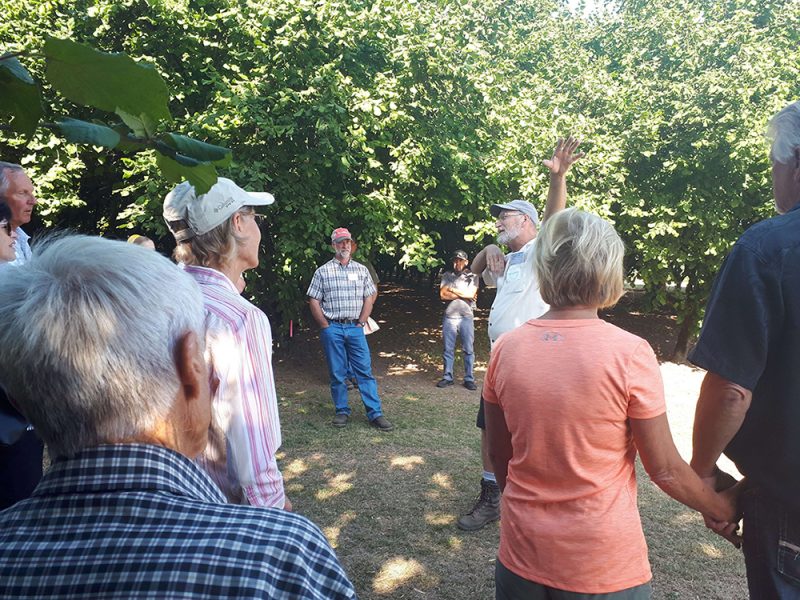ALBANY, OR—Close to 900 hazelnut growers attended the annual Nut Growers Society of Oregon, Washington & BC (NGS) summer tour in Albany, Oregon on July 31. The event included a bus tour, seminars and a trade show that attracted growers from all three jurisdictions, including members of the BC Hazelnut Growers Association (BCHGA).
The highlight was a tour of Wayne Chambers’ orchard, which has the oldest field-grown examples of the Eastern Filbert Blight-resistant varieties developed at Oregon State University.
Chambers has worked closely with OSU since graduating in 1963, the same year that he married his wife Joann and started his hazelnut orchard. Early on, Chambers and OSU worked together on field-testing the results of the hazelnut breeding programs at OSU, starting with scion grafting.
“Wayne’s willingness to provide test plots for OSU has paved the way for us,” says NGS president Christy Cook.
Some EFB-resistant varieties in his orchard are 14 years old. Chambers’ farm has tested 150 varieties in on-farm trials, growing them to maturity. This allows for long-term study and extends the research capacity of OSU, which removes trees after 10 years of evaluation.
“OSU has been saving our bacon; we wouldn’t be able to stay in business if it wasn’t for Oregon State,” says Chambers.
Attention to detail
OSU orchard crops extension specialist Nik Wiman and senior faculty research assistant of the OSU hazelnut breeding program, David Smith, described the various research plots and trees at Chambers’ orchard. Although some varieties in this orchard are susceptible to EFB, diligent pruning and spraying has kept the disease at bay.
“Freedom from disease due to attention to detail,” explains Smith.
The tour also included Paul Kuehne’s new 170-acre orchard, drip-irrigated and drained by soil type. Yamhill, Wepster, York and McDonald varieties were planted using a GPS grid in a 20×10 diamond using an auger. Tree covers are used initially to protect trees from herbicides and sun scald, but after the first year they are removed and the trunks painted with white latex paint.
“Mice were a problem, and suckers are hard to control with covers,” says Kuehne, “Covers help and hurt, so we use them for a bit when they are most useful.”
Bacterial blight has been observed in the new orchard, with York and McDonald most affected at 25% and 10%, respectively. Wepster and Yamhill are more resistant to blight, with only 1% to 2% of trees affected. As a result, Kuehne had the main trees infected cut out and allowed the suckers to grow back. These were treated with two applications of copper spray in the fall.
Tour
The tour drove through Cascade Foods, a hazelnut processing facility in Albany, just down the road from the 100-year-old Groshong orchards with Hall’s Giant hazelnuts, some on Turkish rootstock.
Education sessions included an organic growers roundtable on pest management, pesticide management, water rights and a demonstration of soil erosion prevention through cover cropping and residue management.
The event included a trade show with over 100 exhibitors, including equipment distributors, processors, extension resources, irrigation companies, plant suppliers and more.
Manager at Oregon Hazelnut Marketing Board and NGS director Polly Owen, namesake for the new “Polly-O” hazelnut variety, says EFB resistance breeding will continue, as well as working on other challenges and opportunities for the industry.
“We are seeing more people in hazelnuts, more leading-edge technology and sophistication,” says Owen, who is not alone in her optimism.
Hazelnut growers from BC who attended included both new and established growers and processors. The maturity of the hazelnut industry in Oregon and the opportunities for growth were apparent to BC growers.
“BC hazelnuts are in demand,” says Cornel Van Maren of Chilliwack, who has a new 20-acre orchard.
“It is great to see how much extension support there is in the US,” says Niels Jorgensen of Campbell River, who is preparing his land for planting.


 Maan Farms keeps the focus on family
Maan Farms keeps the focus on family